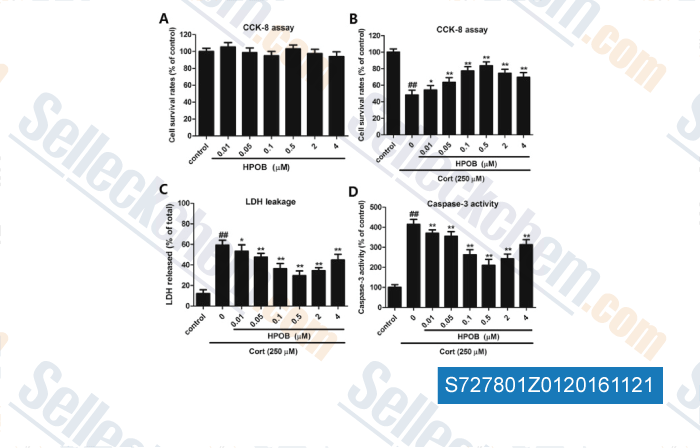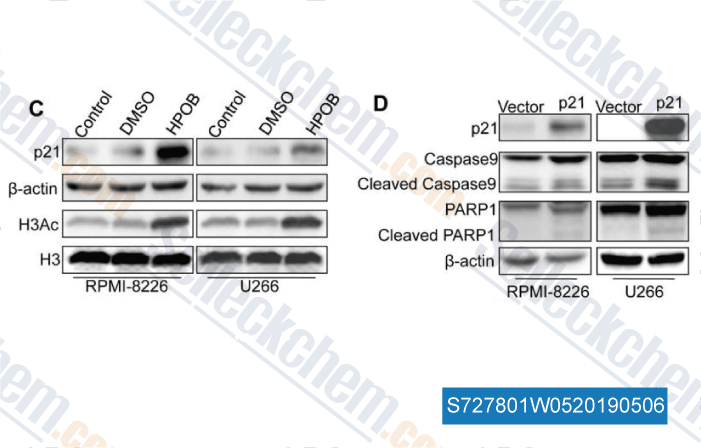|
Toll Free: (877) 796-6397 -- USA and Canada only -- |
Fax: +1-832-582-8590 Orders: +1-832-582-8158 |
Tech Support: +1-832-582-8158 Ext:3 Please provide your Order Number in the email. |
Technical Data
| Formula | C17H18N2O4 |
||||||||||
| Molecular Weight | 314.34 | CAS No. | 1429651-50-2 | ||||||||
| Solubility (25°C)* | In vitro | DMSO | 63 mg/mL (200.41 mM) | ||||||||
| Ethanol | 32 mg/mL (101.8 mM) | ||||||||||
| Water | Insoluble | ||||||||||
| In vivo (Add solvents to the product individually and in order) |
|
||||||||||
|
* <1 mg/ml means slightly soluble or insoluble. * Please note that Selleck tests the solubility of all compounds in-house, and the actual solubility may differ slightly from published values. This is normal and is due to slight batch-to-batch variations. * Room temperature shipping (Stability testing shows this product can be shipped without any cooling measures.) |
|||||||||||
Preparing Stock Solutions
Biological Activity
| Description | HPOB is a potent, selective HDAC6 inhibitor with IC50 of 56 nM, >30-fold selectivity over other HDACs. | |||||||||||
|---|---|---|---|---|---|---|---|---|---|---|---|---|
| Targets |
|
|||||||||||
| In vitro | In normal (HFS) and transformed (LNCaP, A549, and U87) cells, HPOB induces acetylation of α-tubulin, however, not histones, and inhibits cell growth, however, not viability. In HFS cells, HPOB enhances transformed cell death induced by etoposide, doxorubicin, or SAHA. HPOB also enhancing etoposide-induced transformed cell death via the apoptotic pathway in transformed cells. [1] | |||||||||||
| In vivo | In mice bearing CWR22 human prostate cancer xenografts, HPOB (300 mg/kg/d i.p.), when in combination with SAHA, causes suppression of the growth of established tumors, while produces no significant suppression when used alone. [1] |
Protocol (from reference)
| Kinase Assay:[1] |
|
|---|---|
| Cell Assay:[1] |
|
| Animal Study:[1] |
|
Customer Product Validation

-
Data from [Data independently produced by , , Neurochem Int, 2016, 99:239-51.]

-
Data from [Data independently produced by , , Molecules, 2018, 23(5)]
Selleck's HPOB has been cited by 3 publications
| HDAC3 inhibitor RGFP966 controls bacterial growth and modulates macrophage signaling during Mycobacterium tuberculosis infection [ Tuberculosis (Edinb), 2021, 127:102062] | PubMed: 33639591 |
| Anti-Proliferative Activity of HPOB against Multiple Myeloma Cells via p21 Transcriptional Activation [Liu L Molecules, 2018, 23(5)] | PubMed: 29710846 |
| HPOB, an HDAC6 inhibitor, attenuates corticosterone-induced injury in rat adrenal pheochromocytoma PC12 cells by inhibiting mitochondrial GR translocation and the intrinsic apoptosis pathway [Li ZY, et al. Neurochem Int, 2016, 99:239-51] | PubMed: 27522966 |
RETURN POLICY
Selleck Chemical’s Unconditional Return Policy ensures a smooth online shopping experience for our customers. If you are in any way unsatisfied with your purchase, you may return any item(s) within 7 days of receiving it. In the event of product quality issues, either protocol related or product related problems, you may return any item(s) within 365 days from the original purchase date. Please follow the instructions below when returning products.
SHIPPING AND STORAGE
Selleck products are transported at room temperature. If you receive the product at room temperature, please rest assured, the Selleck Quality Inspection Department has conducted experiments to verify that the normal temperature placement of one month will not affect the biological activity of powder products. After collecting, please store the product according to the requirements described in the datasheet. Most Selleck products are stable under the recommended conditions.
NOT FOR HUMAN, VETERINARY DIAGNOSTIC OR THERAPEUTIC USE.
